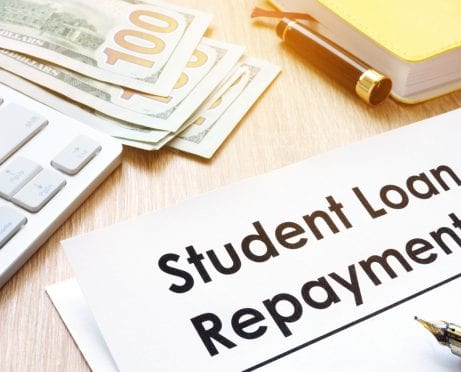
Marie Blanc cried at the sight of her staggering balance. She hadn’t looked at her student loan bill in the several months since she’d lost her job at a local distribution center. In fact, she hadn’t looked at it at all since she’d set up automatic payments.
Now she owed more than $52,000 for a degree that she wasn’t using.
Blanc had graduated high school with honors and thought the job market would be ripe with opportunity. She opted to pursue a college degree in communications to open doors to what she thought was a burgeoning industry. She signed off on federal student loans and was, by all accounts, doing everything right.
Seven years later, Blanc lost her job when her company declared bankruptcy. And so, she defaulted on her $684 in monthly student loan payments.
What Does It Mean to Default on Public Student Loans?
About 15 percent of student loans are in default at any given time, according to EducationData. Failing to make a payment does not automatically lead to default. The day you miss a payment you become delinquent. Though the delinquency is not reported to the three national major credit bureaus for 90 days, it’s essential to take immediate action.
Although federal loans usually offer lower interest rates, private student loans are another way of paying for college if you surpass the federal student loan maximum. (See below for the consequences of defaulting on private loans.)
What Are My Options if I Can’t Repay My Public Student Loans?
Remember there are options if you find yourself in a situation where you can’t meet your monthly payments.
Though it’s scary to owe money you can’t immediately repay — doing nothing is the worst choice. The first step is to read your loan agreement. Seek help from a trusted family member or friend if you have difficulty understanding some of the terms. Create a realistic budget, so you know exactly where you can cut costs and put money toward debt repayment.
Next, decide if one of these options makes sense for you.
The first option is an income-based repayment plan. Everyone should consider this option first because, for many individuals, an income-based plan will have a payment of zero.
Remember, your loan servicer will probably want to work with you to ensure they receive their money back. It’s essential to contact your loan servicer immediately to negotiate payments you can realistically afford.
Another option is student loan deferment, which allows you to temporarily stop making payments. Deferment is commonly used when there is a triggering event, such as returning to school, and can be for an extended period of time, like while you’re getting an advanced degree. During deferment, no interest accrues on subsidized or Perkins loans.
If you do not qualify for deferment, your next and last option is forbearance. This is a temporary pause or reduction of your student loan repayment, which you apply for with your loan servicer, according to the U.S. Department of Education (DOE). Forbearance is for up to 12 months, then you must reapply.
Keep in mind, a key difference between forbearance and deferment: In deferment, your student loans stop accruing interest on the owed balance whereas in forbearance interest will continue to accrue.
“Between the two, deferment is clearly more advantageous, although it’s usually available only for subsidized federal student loans or to borrowers who meet qualifying criteria, such as being unemployed or facing significant financial hardship,” states certified financial planner Thomas J. Block.
“For individuals who don’t qualify for deferment, forbearance can be a prudent path to overcome short-term financial difficulties. The application process is relatively straightforward, and no specific qualifying criteria must be met. However, forbearance is not a sensible solution for long-term financial problems,” Block continues.
“In these situations, income-driven repayment plans are much more effective. These types of plans tie monthly payments to earnings, which can help overburdened borrowers better manage their budgets over the long run,” Block adds. Many of these plans offer the added benefit of debt forgiveness, after a period of repayment.
However, despite having these options available, some people find themselves facing a loan default. This generally means that a person has not submitted a payment in more than 270 days, according to the DOE.
The Federal Perkins Loan Program is an exception to this, as it allows the loan holder to declare the loan to be in default if the payer fails to make even one scheduled payment, according to the DOE. (Since the Federal Perkins Loan Program ended in 2017, however, new borrowers do not need to worry about this).
Student loan default can be resolved quickly, but you will need to make repayment arrangements by contacting your loan servicer. If the situation is left unresolved, there are many financial consequences.
Defaulting on private student loans is very different from defaulting on federal student loans, and the consequences can be as well, according to the National Consumer Law Center (NCLC). Here are some of the differences:
- Bankruptcy or death of the primary holder can cause default for holders of private student loans.
- A co-signer’s death or bankruptcy can also cause default, even if payments are promptly made. This can be avoided by obtaining a co-signer release, using sample letters from the Consumer Financial Protection Bureau.
- Private student loans can go into default after only 120 days, according to the NCLC.
- Defaulting on one loan can cause all loans with that lender to go into default.
- Private loans are not subsidized by the federal government and are not as closely regulated as federal loans.
- Private student loans do not have the same protection that federal student loans offer.
- Private lenders are not required to offer flexible repayment plans.
- Private lenders may hire a private collection agency in order to receive payment, according to the NCLC.
- Private lenders may also use lawsuits in order to collect payments.
- Consumer protections vary depending on the state you live in, according to the NCLC.
The Consequences of Ignoring Loan Notices
Because Blanc had ignored her bill for 11 months (well past the 270-day limit), she didn’t qualify for payment plans, forbearance, or deferment.
Instead, Blanc watched her 700 credit score quickly plunge. “You could pinpoint the day I became delinquent by the large dip in my score’s chart,” she later noted.
Because her credit score took a nosedive, Blanc became stuck, trapped under the weight of her now 600 credit. No one would give her a loan for a much-needed used car or rent her a new apartment. Moving back home and relying on her retired parents’ kindness was her only option.
Then, the phone calls started.
Blanc blocked the “unknown” numbers one by one until she grew frustrated and simply hung up before they could even say hello. After she defaulted, her loans were sold to multiple collectors and she had a new set of bills to deal with instead of her single payment through her prior loan servicer.
To make matters worse for defaulters, there are other consequences, according to the DOE. Defaulters can lose payment plan options and wages may be garnished. Loan holders can file a lawsuit, and the remainder of the loan becomes due immediately. Schools can even choose to withhold transcripts if debts are not repaid.
Defaulting on a Private Loan vs. a Federal Loan
Defaulting can have different consequences depending on whether the borrower has federal or private student loans. Though federal loans allow borrowers to repay their debts and eliminate a record of their default, private loans are not so forgiving.
“Unlike federal loans, private student loans don’t have programs to ‘undo’ a loan default,” says Leslie H. Tayne, a debt resolution attorney and founder of Tayne Law Group. “It’s important to act quickly and contact your lender because many private loan companies will send loans to collections and charge off the loan after four months of missed payments.”
“They could also send the defaulted loan to an attorney for a suit,” Tayne adds. “If you find yourself in this situation, you can seek out a reliable firm to assist you with resolving the debt with your servicer.”
Getting Honest About Defaulting
For Blanc, a friend sharing his story led her to a solution. He, too, had defaulted on a $35,000 loan a few years earlier. He had benefited from actually facing his problem head on through a Federal Loan Rehabilitation program. These programs work with the loan department to set up a payment plan.
“Rehabilitating defaulted federal student loans can remove the default from the borrower’s credit history. This requires making nine out of 10 consecutive full voluntary reasonable and affordable monthly payments as part of a loan rehabilitation agreement,” states financial aid expert Mark Kantrowitz.
“Monthly loan payments under an income-driven repayment plan are considered to be reasonable and affordable. In some cases, the borrower may qualify with a lower monthly loan payment. The main drawback is loan rehabilitation is a one-time opportunity. If you default again, your only option will be to pay the debt in full,” Kantrowitz adds.
Though loan rehabilitation programs may take months to complete, if you qualify for one and feel you can stick with the program, your credit score may improve and your monthly payment may decrease.
After six months of on-time payments, the loans are reinstated and the default is cleared.
Blanc finally had the courage to call and got her monthly payment reduced significantly. She began waiting tables and working other odd jobs to earn extra income. Soon she had enough to make six monthly payments on her loan, effectively reinstating them.
Once her loans were back in order, Blanc tackled her credit by slowly improving her score. However, a year later, she has bumped up her number only to 650. The consequences of defaulting on a student loan are still following her.
Overcome Your Debt and Save Money
Recovering After Defaulting on Student Debt
Blanc and the 9 percent of student loan borrowers who are currently delinquent, according to the Federal Reserve Bank, haven’t found life after default to be a walk in the park. They must deal with the real cost of defaulting on a student loan head on. But there are solutions.
One solution is to refinance your student loans as a way of reducing monthly payments. This is accomplished when you are able to qualify for lower interest rates that lower the costs of repayment.
Refinancing can also help consolidate all payments to one lender, which makes it easier to stay on top of due dates. Your credit score greatly benefits from timely payments.
Another option: “Contact your loan servicer immediately to work out a payment plan and explain why you haven’t been able to pay your loan,” says Tayne. “If you have a federal student loan, loan rehabilitation and loan consolidation are options to consider.”
“The loan rehabilitation program is initiated by contacting your loan servicer and agreeing to make nine consecutive monthly payments (calculated by the servicer),” Tayne adds. “Once the payments have been made, the loan will no longer be in default, and federal benefits including loan forgiveness, deferment, changing the repayment plan, and forbearance become available again.”
“While the late payments made will still appear on your credit reports for seven years,” Tayne continues, “the default will be removed from reports.”
With loan consolidation, Tayne explains: “You must agree with your lender to repay the consolidation loan through an income-based repayment plan or make three on-time, full payments in a row before consolidating.” There are drawbacks, however, to pursuing this option. Consolidation does not remove the “default” record from credit reports.
The Bottom Line
Defaulting on your student loans is not the end of the world. As long as you take the right steps and act quickly, you can recover from default and save your credit. It won’t be easy, but it is possible.
Additional reporting by Ellie Schmitt and Lukas Shayo.
Additional background information for this article was provided by debt resolution attorney and founder of Tayne Law Group, Leslie H. Tayne, Esq.










